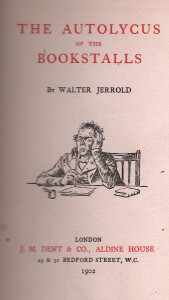 We at Jot 101 had not imagined the travel writer and biographer Walter Jerrold ( 1865 – 1929 ) to be a frequenter of second-hand bookstalls, but there he is as an unabashed collector of ‘unconsidered trifles ‘ in Autolycus of the Bookstalls (1902), a collection of articles on book-collecting that first appeared in The Pall Mall Gazette, Daily News, the New Age, and Londoner.
We at Jot 101 had not imagined the travel writer and biographer Walter Jerrold ( 1865 – 1929 ) to be a frequenter of second-hand bookstalls, but there he is as an unabashed collector of ‘unconsidered trifles ‘ in Autolycus of the Bookstalls (1902), a collection of articles on book-collecting that first appeared in The Pall Mall Gazette, Daily News, the New Age, and Londoner.
But as we already knew him as a biographer of Charles Lamb we should have known better, and indeed he mentions Lamb several times in his book. Jerrold’s range as a bibliophile was wider than Lamb’s, but he seems to have been particularly drawn to writers of the Romantic period. He wrote about collecting Thomas Hood, Cobbett, Coleridge, Southey, and Rev Sydney Smith, while also mentioning books on Oliver Cromwell and Ruskin. In addition, he appears to have rather liked association copies of all dates, and boasted that he had ‘snapped up ‘volumes bearing the signatures of Cardinal Manning, George Eliot, Sydney Smith and Thomas Noon Talfourd at ‘Metropolitan stalls’ in recent years. Jerrold was also tickled at the idea of buying books that had been displayed in the windows of very unliterary shops—in one particular instance an ‘ oil and colourman’s shop in the Seven Dials’, where a first of Ruskin’s Political Economy of Art and a Tennyson signed by George Eliot rubbed shoulders with ‘ soap, soda, pickles and jam ‘. Finding literary treasures in unlikely stores was probably more common in Jerrold’s time than it is now, although your Jotter does recall his first entry into collecting back in 1968, when he found an odd volume of the fifth edition of Johnson’s Dictionary and a battered early edition of Gay’s Fables, complete with nice copper plates, in the window of a car mechanic’s shop opposite Sketty Library in Swansea, along with spanners and a grease gun. After negotiating with the mechanic he secured the two tomes for just 2/6 ( 12p ).
Jerrold favoured ‘ Booksellers’ Row ( aka Holywell Street, off the Strand ), a disreputable area cleared for the construction of Aldwych c 1900, from where he moved to ‘ that newer Booksellers’ Row which has sprung up in Charing Cross Road ‘, itself a product of slum clearance a little earlier. He also ( in passing ) mentions the stalls in Farringdon Street, for so many decades dominated by the Jeffrey family (see earlier blog in Bookride) , and Aldgate, in addition to the New Cut opposite Waterloo station. The two latter sites went many years ago and following the demise of George Jeffrey, the Farringdon bookstalls, where a lucky punter a few decades ago bought an early sixteenth century scribal copy of a work by Sir Thomas More for a few pounds, folded within a year or so. Today the only surviving ‘Booksellers’ Row ‘ is in Charing Cross Road.
One assumes that greater bargains were to be had in late Victorian times than in the late twentieth century, but one would be wrong. Jerrold boasts of buying a quite rare sixteen-page autobiography by Cobbett dated 1818 for a penny, but one penny ( ½ p.) in the latter years of Queen Victoria would be worth well over £2 today, and one can imagine such a thing as the Cobbett pamphlet being ‘snapped up ‘for around this sum at the Farringdon stalls in, say 1980.In contrast, ten years later your Jotter was happy to secure an exceedingly rare second edition dated 1570 of Foxe’s Actes and Monumentes at Farringdon for £50 ( worth £1,500 today). Similarly, Jerrold exults in obtaining a fifteen volume uniform edition of Pope’s Works dated 1770 for 3/6d ( 17p.). Rather a better bargain in 1970 was the rare 6 volume pirated edition of Pope dated 1765 that your Jotter picked up for £1 17s 6d from Ralph Wishart, the bookseller friend of Dylan Thomas. In general, then, Jerrold’s connoisseurship is not impressive. He seems to have bought later editions, rather than firsts. For instance, he gets excited at reading John Wilkes’s attack on Lord Bute in an edition of The North Briton dated 1784 without acknowledging that Wilkes had edited this famous journal in the 1760s. By 1784 the once fiery radical had been condemned by many for quelling the Gordon Riots of 1780 and later became a rather conservative figure in politics. Similarly Jerrold is thrilled at reading an edition of Bacon’s famous Essays…’ enlarged by the author himself’ and dated 1673, which was 47 years after its author had died.
Surely the real thrill in collecting comes with discovering very rare books and pamphlets by politicians, scientists and philosophers or slim volumes of verse by poets who later became famous (such as the Fitzgerald Omar Khyaam he mentions early on in his book ), or first editions of celebrated works of fiction. Finding an umpteenth edition of Bacon and getting carried away simply because it’s old, isn’t really on the scale where excitement is concerned. The only first edition acquired by Jerrold that would get the heart of a collector pumping today if bought for the equivalent of ‘ a few shillings ‘ is a copy of Coleridge’s brilliant Biographia Literaria (1817) . Now that was certainly worth devoting a few pages of Autolycus of the Bookstalls to. As for the rest of this over- long and rambling book, your Jotter is not so sure… [R R]
